A knitted hat is a stylish winter headdress that can be made with knitting needles from wool or semi-wool yarn. Made with a simple elastic band or decorated with a braid pattern, it varies in complexity of execution.
You can try to knit a hat yourself, using detailed diagrams with descriptions as a guide.
Necessary materials and tools
The knitting pattern for a hat (the diagram with a description of knitting is given below in the article) performs not only a decorative function, but also significantly increases the density of the product, making it more voluminous, reliably protecting from cold wind and frost.
A wide variety of patterns of varying degrees of complexity allows each master to choose the knitting technique that suits him, focusing on his own skills and experience, as well as the materials chosen for the work.
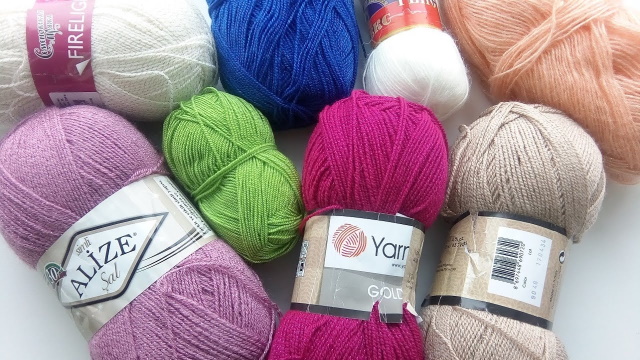
| Yarn | To create hats, it is recommended to use high-quality wool or semi-wool yarn, which has a thickness from medium to thick. The footage of such yarn in one skein is from 200 to 300 m. The most suitable yarn would be merino or alpaca wool, to which acrylic or nylon is added, the content of which should be at least 10-15% of the total yarn composition. This allows you to get a material with certain properties, such as softness and elasticity, and also extend the service life of the finished product. Among the most popular brands of yarn for making hats are the following: · Pekhorka is a Russian-made yarn, distinguished by its high quality and affordable price. It is made from merino wool with the addition of acrylic, which makes it soft and elastic. · Alize is a Turkish yarn that is distinguished by a variety of colors and textures. It contains alpaca or merino wool, acrylic and polyamide. · ALPI is another Turkish brand that produces yarn from natural wool and acrylic. · Lana is an Italian yarn made from alpaca and merino wool with a small addition of acrylic. It is soft, warm and durable. |
| Spokes | When knitting, you can use different types of knitting needles, such as straight and circular (shuttle). The choice of knitting needle type depends on the diameter of the yarn. The diameter of the knitting needles can be equal to the diameter of the thread or 1-2 sizes smaller. Using knitting needles smaller than the thread will make the pattern more complex and voluminous.
For beginners, wooden or bamboo needles are suitable, as well as aluminum needles. These materials are quite light and inexpensive, which makes them a good choice for beginners in knitting. |
| Additional elements | · scissors;
· knitting marker; · thread with a needle; · notebook for notes; · ruler. |
Master class on making patterns
The choice of technique depends on the skill level of the knitter. The variety of techniques allows you to find your own unique style. It can be a classic and laconic option or a bright and original one.
Garter stitch
The knitting pattern for a hat (the diagram with the description includes rows with only front and back loops) in garter stitch is a simple and universal option.
This knitting gives the product a dense and uniform structure. This provides reliable protection from cold and wind, making the hat suitable for the winter period. The garter stitch pattern is considered one of the most popular and easy to master.
It can be used to create a variety of hat models, including a stocking hat made with straight knitting needles. It allows you to create beautiful and functional things without unnecessary complications.

When creating a product, you need:
- Place 33-37 stitches on the needles and knit in garter stitch, making only the front stitches:
- 1st row of 28-30 loops, and turn the product.
- 18 loops in the 2nd row and turn the fabric over.
- 3rd row, consisting of 23-25 loops.
- Turn the fabric over and knit the 4th round completely with the front surface.
- In the 5th row, knit 26 loops, turn the product and completely knit the 6th row.
- Turn the piece over again and continue knitting, repeating the pattern in rows 1-6.
- As soon as the hat reaches a length of 52-58 cm (along the bottom row), take a needle and thread and connect the first with the last row. Gather the remaining loops on the crown, tighten the thread and secure well.
- Wet and steam the finished hat.
When knitting with circular needles, the front rows must be complemented with back rows.
Knitting pattern:
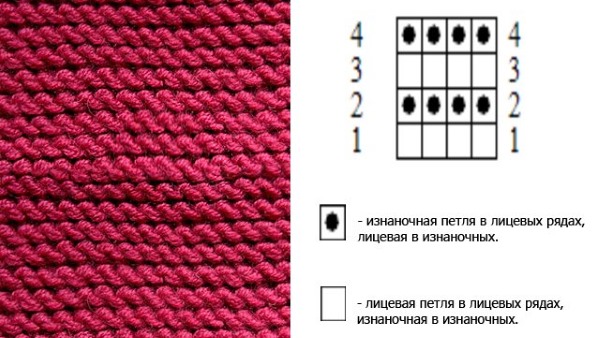
| In the 1st row | The first loop is removed, after which the row is completely knitted (it must be finished with a purl loop). |
| In the 2nd round | The first loop is removed, after which only purl loops are knitted in a circle. The last loop in it is the front loop. |
| 3rd and all subsequent odd circles | Knit the same as the 1st row |
| 4th and even rows | Performed according to the 2nd circle report. |
Pearl
A pattern for a hat knitted with knitting needles (a diagram with a description allows you to understand the features of the ornament) pearl elastic is one of the simple options for elastic.
Also called rice, putanka or moss, it refers to double-sided patterns and involves the obligatory knitting of alternating rows with purl loops located above the front ones and vice versa.
To create a hat with a pearl pattern lapel, you need to:
- Place any even number of loops divisible by 2 (for example, 110-120) on the knitting needles and knit 1 round entirely in stockinette stitch.
- Starting from the 2nd row, start knitting the pearl pattern, while the repeating pattern in the 2nd row will consist of 1 front and 1 back loop.
- In the 3rd row, it is assumed that 1 purl and 1 front loop are knitted 7-8 times.
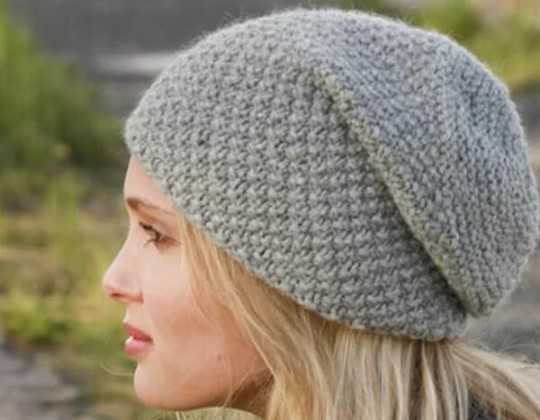
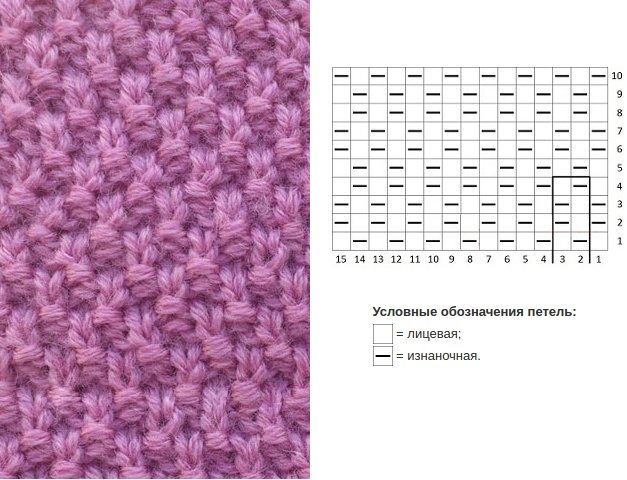
- With constant alternation of rows, work on the model continues until the fabric reaches a height of 21-25 cm (+ 12-16 cm to form the lapel).
- Start creating the crown. To do this, perform a decrease, in which all the loops in the row are marked through 15, and then knit together 3 purl or face (depending on the alternation) loops. The decrease is repeated in every 3rd row.
- When there are only 10-12 loops left on the knitting needles, finish the work by pulling the thread and securing it.
Other options
In addition to the classic pearl pattern, other types of elastic bands are also used when knitting hats.
Elastic band 2*2
The voluminous vertical-longitudinal rows that decorate knitted items are obtained using a 2*2 elastic band. It is created with the initial set of loops, divided by 4 (it is also necessary to include 4 (2 edge and 2 for symmetry) additional loops in it.
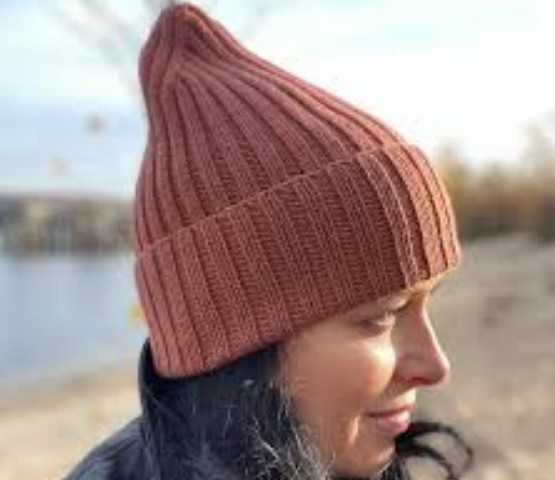
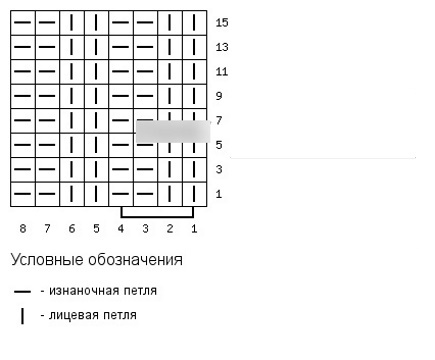
The pattern execution scheme involves knitting:
- In the 1st row, the pattern repeats from alternating 2 front and 2 back loops.
- 2nd row due to the alternating pattern of 2 purl and 2 front loops.
Further work is carried out using the rapport of the 1st row in all odd (3, 5, 7, 9) rows, and the ornament of the 2nd circle in all even (4, 6, 8, 10) rows.
Twisted
A twisted elastic band is a variation of the 2*2 elastic band.
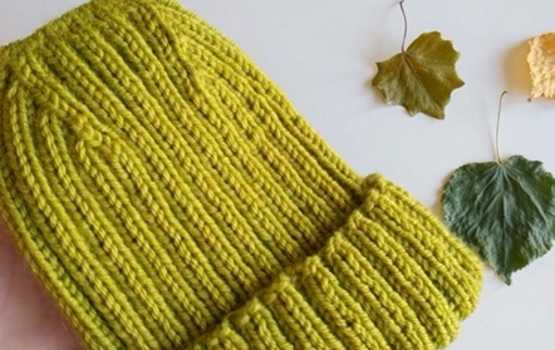
Pattern rapport between edge loops:
| 1st row | 2 front loops are knitted together through the front wall and 2 back loops are knitted. |
| 2nd row | 2 purl loops are knitted behind the front wall, and then 2 front loops are made. The pattern is also repeated 8-10 times, and the row should end with a front loop. |
Then knitting continues with alternating execution of the rapport of rows 1 and 2.
Swedish faceted
Swedish faceted elastic consists of 2 alternating rows.
It starts with a set of loops that are easily divisible by 4, after which the following is performed:
- 1st round with a pattern of 3 front and 1 back loop.
- Starting the 2nd round, knit stitch, then knit a pattern with 1 purl and 3 knit stitches 8-10 times.
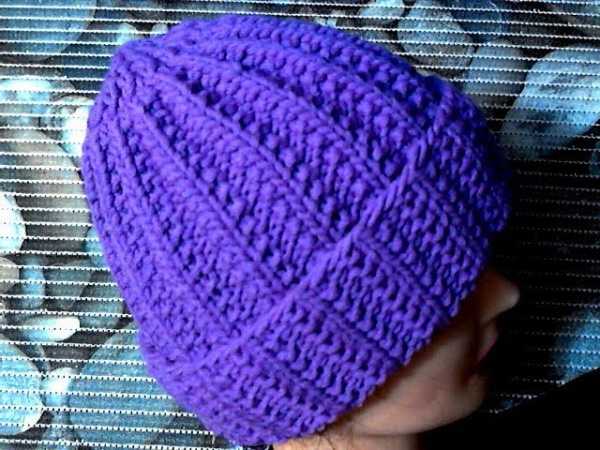
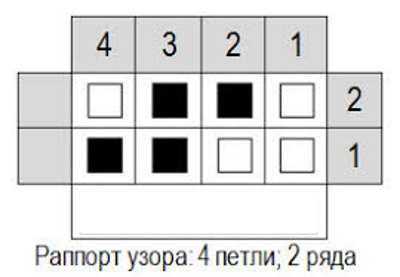
When knitting the hat further, you need to constantly repeat the rapport of rows 1 and 2.
American
American or Scottish elastic consists of 3 loops + edge loops.
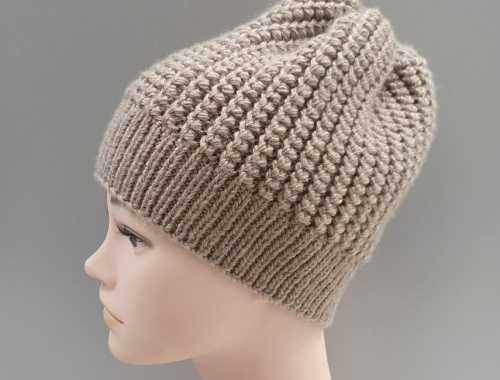
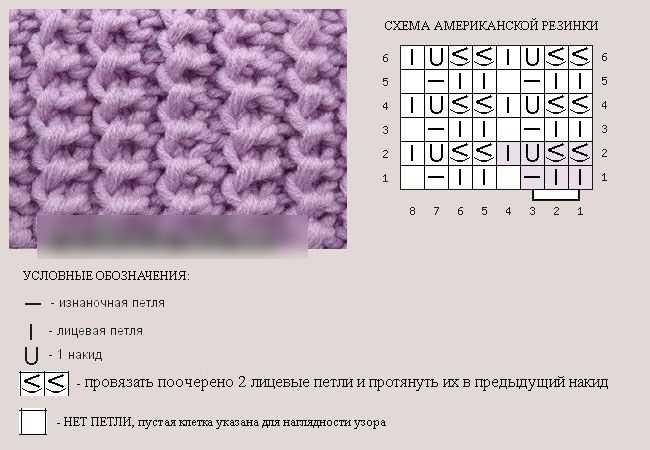
Pattern repeat:
| 1st circle | 2 front loops + 1 back loop (repeated around the entire circle). |
| 2nd row | You need to start it with an edge loop, and then do the pattern 7-9 times - 1 front loop and yarn over, 2 front loops knitted together, pulled through the yarn over. The circle is also finished on the edge loop. |
French
A knitted hat pattern (a diagram with a description will help you avoid mistakes), made with French or Polish elastic, looks the same on the front and back sides.
It is created by initially casting on loops, divisible by 4, according to the following pattern:
- 1st row – repeating pattern with a purl stitch knitted through the front wall + 3 front stitches (the 2 outer ones are knitted through the front wall, and the middle one is knitted through the back wall).
- 2nd round – 1 front + 1 back loop + repeating pattern in a circle of 3 front loops and 1 back loop.

Then the work is repeated with constant knitting of the patterns of the first 2 rows.
English
The English elastic looks most advantageous when knitting women's berets and beanie hats. It consists of 3 rows, constantly alternating and following each other.
The pattern repeats throughout the row:
| 1st row | A pattern of 1 front and 1 back stitch is performed. |
| 2nd row | The pattern, repeated around the entire circle, includes 1 front loop + 1 back loop, transferred together with the yarn over without knitting from the left needle to the right one. |
| 3rd row | A rapport is made of 1 front loop, knitted together with a yarn over hanging above it for the upper wall, and a purl loop, removed without knitting together with the yarn over. |
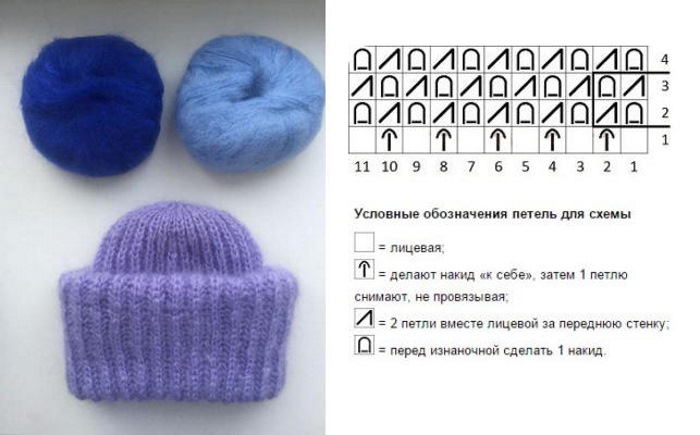
Further work on the pattern involves constantly performing the rapport of the 1st-3rd circles.
Network
The braid pattern is used when knitting warm, double, voluminous hats.
It is knitted, according to the description, using a pattern with crossing 4 (2*2), 6 (3*3), 8 (4*4) and more loops from thick wool yarn with circular knitting needles, while the initial set of loops will directly depend on the selected pattern (it should be divisible by 2, 3 or more).
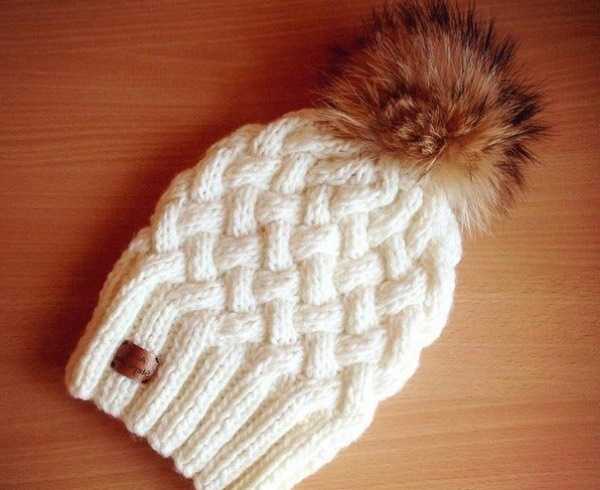 To make a hat using 2*2 braiding you will need:
To make a hat using 2*2 braiding you will need:
- Using knitting needles, cast on a number of stitches divisible by 4 and do the following:
- Only knit stitches on the 1st row and completely purl stitches on the 2nd row.
- In the 3rd row, knit a repeating pattern 5-7 times, transferring 2 loops to an additional knitting needle (yarn in front of work) and knitting the next 2 as front loops. After them, the loops removed from the additional knitting needle are also knitted as front loops.
- In the 4th row, first make 2 knit stitches, then the pattern (repeat it 5-7 times) of 2 stitches transferred to an additional knitting needle (yarn in front of work), 2 knit stitches and returned from the additional knitting needle, made knit stitches.
- Then the pattern is repeated from the 1st to the 4th row.
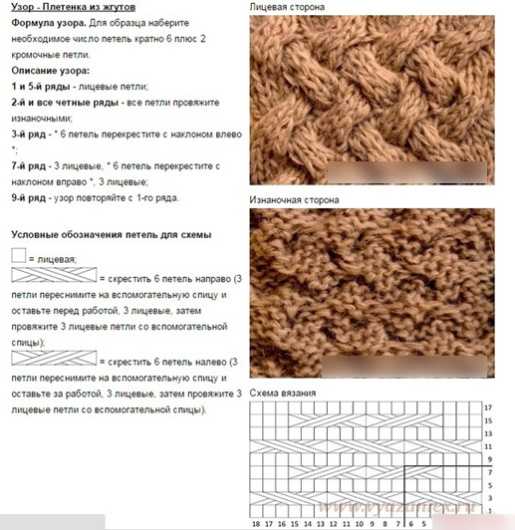
The knitting of the 3*3 crossing pattern is done in the same way.
Volumetric patterns
Volumetric patterns are used to create beautiful and warm knitted hats, quite voluminous, decorated with relief patterns.
Depending on their type and method of execution, they look like reliefs made in the form of wide paths, squares, zigzag lines, or are complemented by English elastic.
Embossed "Paths"
The relief volumetric paths are a one-sided pattern, performed in a circle, alternating with elements of garter stitch. It is knitted in turning rows, and the rapport consists of 5 loops and 4 rows.
When performing it, you need to:
- Cast on a number of stitches divisible by 5 and add 3 stitches to it for pattern symmetry and 2 edge stitches.
- Knit the 1st row completely with front loops.
- In the 2nd row, make a repeating rapport of 3 front and 2 back loops. It ends with 3 front loops.
- Knit the 3rd row only with knit stitches, and do the 4th row exactly like the 2nd round.
- Start knitting a voluminous pattern, for which in the 5th row repeat at least 5-6 rows of the rapport of 3 front loops, after which you will need to go down 3 rows below (between 3 and 4 loops) and pull the loop out from under the third broach.
Next, the rapport continues with 2 front loops and a loop pulled from the bottom 2nd row (3 rows below) from under the third draw. The row ends with front loops.
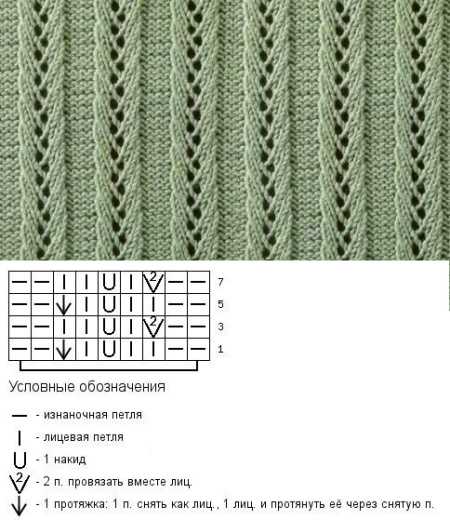
- In the 6th row - a pattern that repeats 7-8 times consists of 3 front loops, after which the loop is removed and transferred to the front side (thread in front of the work), 2 purl loops are made, the loop is again removed to an additional knitting needle and transferred to the thread in front of the work.
The row ends with 3 knit stitches.
- Rapport of the 7th row - 3 front loops + 4 loops knitted together as front loops, first behind the back wall, then behind the front wall. The last in the row are 3 front loops.
- Row 8 – a pattern of 3 front and 2 back loops repeated at least 7 times.
- Then the work on the pattern is repeated, starting from the 5th to the 8th rows.
"Raspberry"
The voluminous pattern "Raspberry" or "Bumps" is ideal for knitting both adult and children's hats.
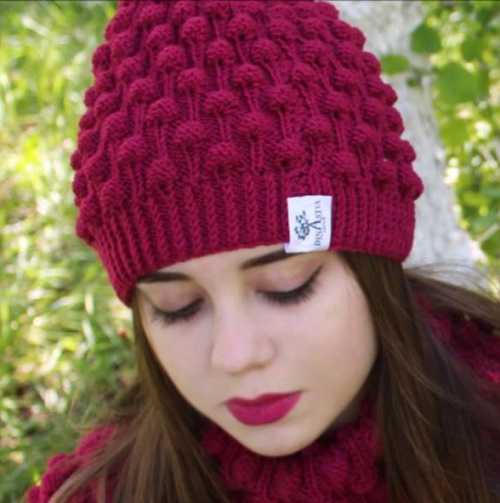
It is recommended to use a wool-based blended yarn for this, for example, Debbie Bliss Cashmerino Aran with 50% merino wool, 35% microfiber and 12% cashmere, as well as straight or circular knitting needles.
The pattern consists of 4 rows, and when knitting a hat you need to:
- Place a number of loops on the knitting needles that is a multiple of 6 + 5 (for example, 102) and knit 8 rows with a 2*2 elastic pattern.
- Go to the Malinka pattern, for this you should start the 1st row with a front loop, and then make a repeating rapport of 2 purl loops, 1 front and 2 purl. From the next loop you need to knit 5 loops (2 times repeat the front loop with a yarn + 1 front).
Do it at least 5-8 times and finish the row with 4 purl stitches and 1 front stitch located between them.
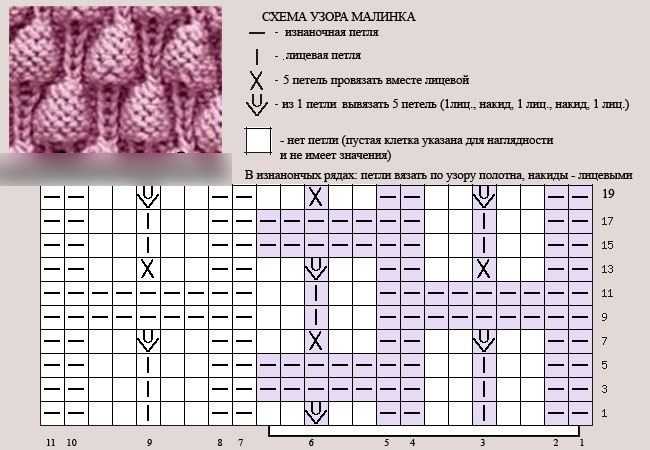
- Starting the 2nd row, make an edge and 2 front loops, and then start knitting a rapport of 1 front and 9 back loops. It is repeated throughout the row, and the circle is completed by placing 1 back loop and 2 front loops before the edge.
- From the 3rd to the 6th row, work continues with alternating patterns of rows 1 and 2.
- In the 7th row, an edge loop is knitted, and then a rapport - 2 purl loops, from 1 loop 5 loops are knitted + 2 purl + 5 loops, knitted together with the front one.
It is repeated 5-7 times, after which you need to finish the row by making 2 purl loops, from 1 loop knit 5 + 2 purl loops and an edge loop.
- In the 8th row after the edge loop, make a repeating 7-8 times of 9 front loops and 1 back loop. The row ends with 9 front loops and an edge loop.
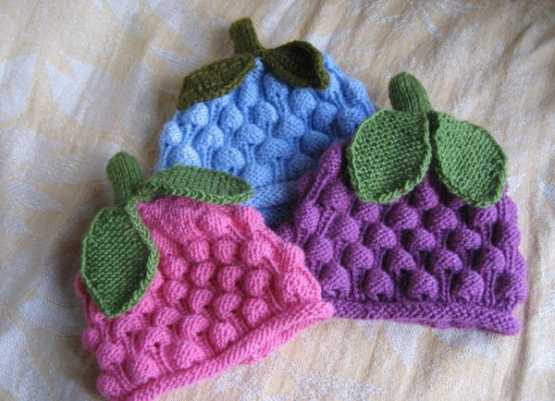
- When knitting rows 9-12, you need to repeat the pattern of the 7-8th circles.
- At the beginning of the 13th row, an edge loop is placed, and then a rapport is made of 2 purl loops + 5 loops knitted together with a face + 2 purl loops, and a loop from which 5 faces are knitted. It is repeated 5-7 times, and the row ends with 2 purl and an edge loop.
- In the 14th row after the edge stitch, a rapport of 2 front loops, 1 purl and 9 front loops is made. The row ends with 1 purl and 2 front loops (before the edge stitch).
- Rows 15 through 18 are knitted in the same way as circles 13 and 14.
- From the 19th row the pattern is repeated (starting from the 17th row).
Cloquet
Knitting pattern for a hat (the diagram with the description of knitting the product must be followed) Cloque is suitable for knitting youth women's or men's demi-season hats. It is recommended to use thin yarn (for example, Brilliant from Vita) and knitting needles No. 2.5 or 3.
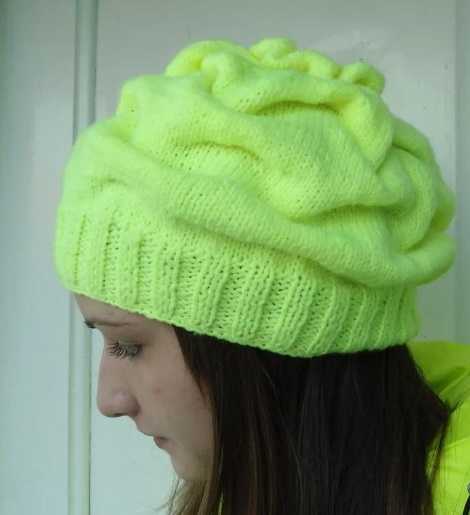
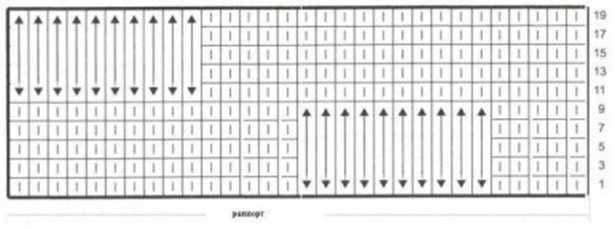
The peculiarity of the pattern is in the creation of relief folds that appear when knitting the front loops together with the loops located 4 rows below them. It is suggested to combine it with the front surface, as well as a simple 1*1 elastic band.
When working on a product you need to:
- Place a number of stitches on the needles that is divisible by 2 (e.g. 110) and knit the first 10 rows in stockinette stitch (knit stitches only).
- In the 11th row, start forming folds by knitting 10 loops through 4 loops together with loops for 10 rows. The folds should be arranged in a checkerboard pattern every 10 rows.
- To complete the pattern repeat in height 25 times, knit 10 rows with the front surface and close the loops.
- Using the remaining loop, pull them together and secure.
Braids
Braids are a classic pattern, ideal for decorating women's and children's winter hats. It can be done in various variations from thick wool yarn or gradient threads according to fairly simple patterns. Such a hat can be complemented with a fur pompom or brooch.
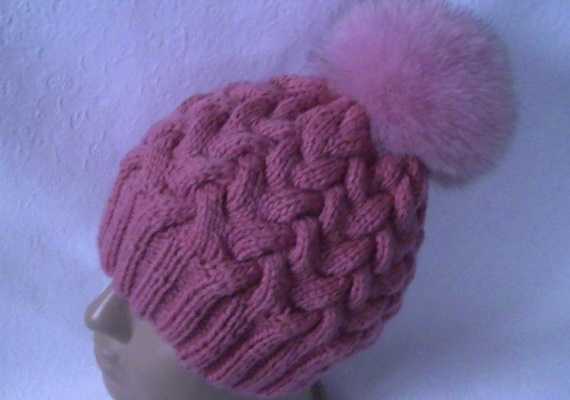
To make a hat with a lapel, decorated with a classic pattern "Large braid" you will need warm merino yarn, with the addition of cashmere, nylon. It will also look incredibly gentle if you choose yarn with mink fluff (for example, KnitFashion).
It is recommended to use circular knitting needles No. 5 and 6.
Knitting is done in 3-4 threads, and during work, you should:
- Cast on 50-80 stitches (depending on the size of your head) using knitting needles, add 1 stitch to them and join the knitting into a circle, then knit 26 rows with a 1*1 elastic band (alternating front and back stitches) to form a cuff (it will be approximately 6-10 cm).
- Start making the main pattern, for which from the 1st to the 7th row (27th to 34th row from the start of work) make a rapport of 5 purl and 15 knit stitches in a circle.

- In the 8th row (35), knit a pattern of 5 purl stitches, 5 stitches slipped to an additional knitting needle in front of the work (front side of knitting), 5 front stitches and 5 stitches knitted from an additional knitting needle through the front wall. The pattern needs to be repeated 5-7 times in a circle.
- Rows 9-15 (36-42 from the beginning of the work) knit according to the rapport of rows 1-7 (5 purl + 1 front loops).
- In the 16th (43rd) row, make a pattern that repeats 5-7 times: 5 purl, 5 knit and 5 loops, removed without knitting onto an additional knitting needle behind the work (wrong side of knitting), 5 knit loops and 5 knitted loops behind the back wall, removed from the additional knitting needle.
- From row 17 (44), the "Braid" pattern will need to be repeated from the beginning (from rows 1 to 16). To make the hat, you will need to knit it 2 more times (from rows 44 to 60 and from rows 61 to 76 from the beginning of knitting).
- To complete the work in the last 4 rows, reduce the loops, for which knit in the 57th (77th row from the beginning of the work) a rapport of 5 purl and 13 front loops + 2 loops, knitted together with a front loop with a rightward tilt.

- In row 58 (78) – a pattern of 5 purl and 12 knit + 2 loops, knitted together with a rightward tilt.
- In row 59 (79), a pattern is made of 5 purl and 11 knit stitches + 2 stitches knitted together with a rightward tilt.
- In row 60 (80) – repeat in a circle the pattern 5 purl + 10 knit + 2 loops, knitted together with a right-hand tilt.
- The remaining loops will need to be pulled together with a thread and the hat secured.
In addition to the classic pattern, you can knit a hat decorated with ovals that complement the braids. It is knitted from medium-thick wool yarn (for example, Ornaghi Merino Maxi, 90 m / 50 g) with the main thread folded in 2 times.
Work scheme:
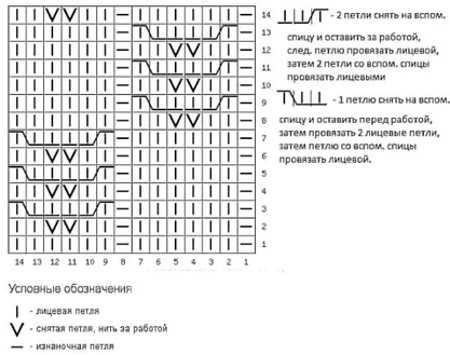
Work begins on smaller needles (eg 4.5) with an initial cast-on of 76-80 stitches + one extra stitch for closing in the round.
In this case:
- At the beginning, as in the first example, 35-37 rows are made for the turn-up with a 1*1 elastic band, and then a transition to larger knitting needles (for example, 5-6) and an additional set of 8 loops is made.
- The next 14 rows are knitted with a rapport, after which it will need to be repeated 4 more times to achieve the required length of the hat.
- The decrease is carried out on the last 6 rows, for which in every 3rd row you should knit together a rapport of 1 purl, 2 front and 2 front loops, knitted together with a rightward tilt.
Left-crossing braids can be used to create both winter and demi-season hats. The fancy pattern resembles the Aran technique and requires the use of medium-thick yarn (for example, Art Angora de Luxe 100 g / 520 m).
Rapport scheme:
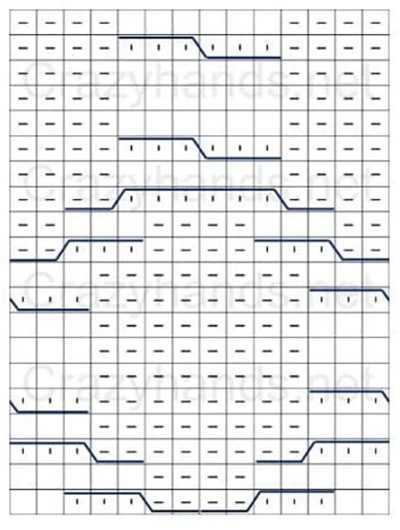
The initial set will be approximately 100 loops, with an additional one-time increase for the pattern of 12 loops. The ornament is combined with a 1*1 elastic band used when knitting the lapel.
Tips for Beginners
To ensure that the product turns out beautiful and of high quality, it is necessary to take into account the recommendations when knitting hats with knitting needles:
- Choose only high-quality yarn for work, without saving on its cost, which will guarantee a beautiful, wear-resistant product that is not itchy and pleasant to wear.
- It is best to start knitting on straight wooden or bamboo knitting needles.
- Monitor the tension of the thread. It should not be pulled too tightly, since the finished product will be very dense, but it should not be loosened too much either.
- When knitting in the round (especially with a rib or garter stitch), use a marker to mark the beginning and end of each circle. You should also hang it up if you need to put the work down abruptly, which will allow you to not get confused later and complete the pattern correctly.
- Use a notebook for knitting, where you can mark the patterns you have chosen, the calculations you have made, and the number of decreases and increases you have made.
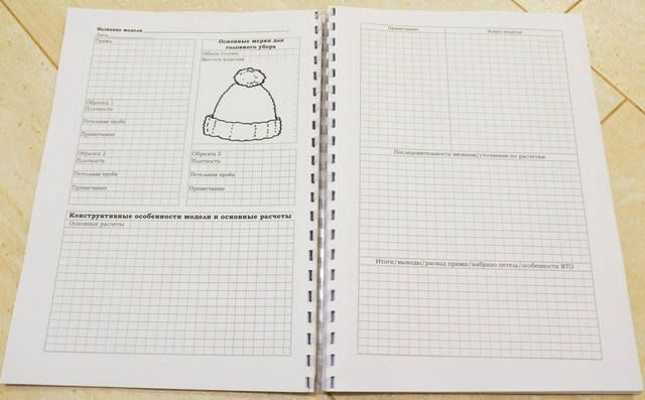
The patterns used in knitting hats are varied, and the master can choose the one that suits him depending on his experience.
Made from wool, down or cashmere yarn, they vary in complexity and technique, and also require adherence to a pattern and description that determines the movement of the needles, the location and number of loops cast on.
Video about knitting
Knitting pattern for a hat:
